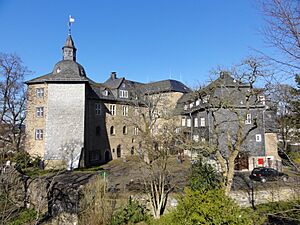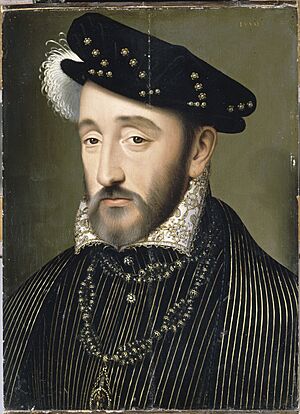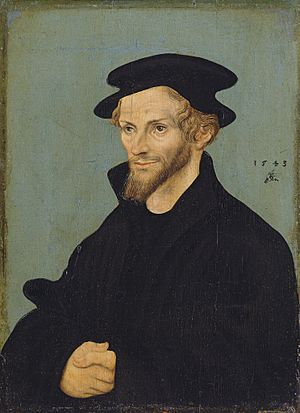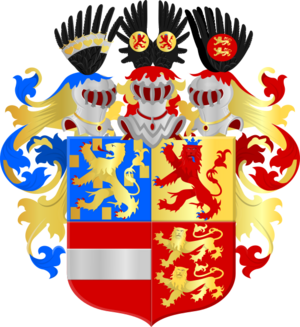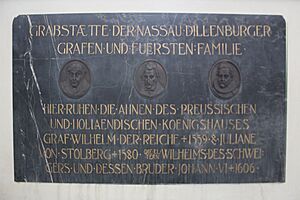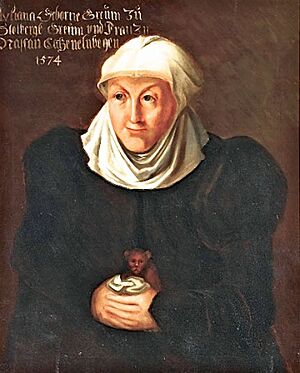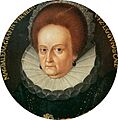William I, Count of Nassau-Siegen facts for kids
Quick facts for kids
William I, Count of Nassau-Siegen
|
|
|---|---|
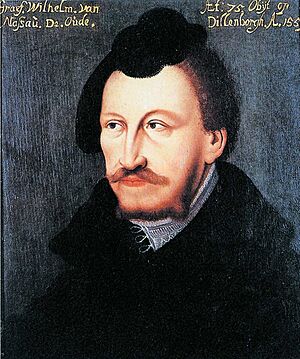
Portrait by Dutch artist Johannes Tideman (1671)
|
|
| Count of Nassau-Siegen Count of Diez |
|
| Coat of arms |  |
| Reign | 30 July 1516 – 6 October 1559 |
| Predecessor | John V |
| Successor | |
| Native name | Wilhelm I. Graf von Nassau-Siegen |
| Born | 10 April 1487 Dillenburg |
| Died | 6 October 1559 (aged 72) Dillenburg |
| Buried | Fürstengruft, Evangelische Stadtkirche, Dillenburg |
| Noble family | Nassau-Siegen |
| Spouse(s) |
Walburga of Egmont
(m. 1506; died 1529)Juliane of Stolberg-Wernigerode
(m. 1531) |
| Issue more... |
|
| Father | John V |
| Mother | Elisabeth of Hesse-Marburg |
William I of Nassau-Siegen (born 10 April 1487 – died 6 October 1559) was a powerful ruler. He was known as the Elder or the Rich. William was the Count of Nassau-Siegen and half of Diez from 1516 to 1559. He belonged to the Ottonian Line of the House of Nassau.
William's time as count was very important for his family. He brought the Reformation (a big religious change) to his lands. He also made his county bigger. William supported the Lutheran faith. He played a key role in the politics of his time. This included joining the Schmalkaldic League and helping with the Peace of Passau. William was a calm and determined leader. He used his diplomatic skills to help solve problems in the Holy Roman Empire.
A big challenge for William was a long argument over who would inherit the County of Katzenelnbogen. This fight was called the War of the Katzenelnbogen Succession. It was a dispute with the Landgraviate of Hesse.
In Dutch history, William is mainly remembered as the father of Prince William the Silent.
Contents
Early Life and Education
William was born in Dillenburg on 10 April 1487. He was the fourth and youngest son of Count John V of Nassau-Siegen and Elisabeth of Hesse-Marburg. William spent most of his childhood in Siegen. He learned how to use weapons from a young age. He also rode horses often with his older brother Henry. William spent time in the County of Vianden, where he learned both French and German.
At age ten, William went to the royal court in Heidelberg. There, he learned Latin. He also made important friends in the Palatinate. He traveled a lot through German lands. He even visited Elector Frederick III the Wise in Saxony. These trips helped him later in life.
William's oldest brother, Henry, lived with their uncle Engelbert II in Breda and Brussels. When Engelbert died in 1504, Henry inherited his lands in the Netherlands. William's other older brother, John, died the same year. This made William the only heir to his father's lands.
William gained his first military experience during the War of the Succession of Landshut (1504–1505). He was a captain of a cavalry group. In 1505, he met Emperor Maximilian I. He also met Walburga of Egmont, who he would later marry. Their wedding in 1506 was a grand event. Many important nobles attended. Soon after, William set up his own home at Dillenburg Castle.
Ruling the County of Nassau-Siegen and Diez
When his father died in 1516, William became the count. His county was about 1,600 square kilometers. It had about 37,500 people living in 15 cities and 550 villages. The county's main income came from farming and especially from iron ore mining. The counts received a share of the iron ore and fees from the smelters. William cared about the iron industry, which was very important for his land.
In 1520, many counts formed groups called Korrespondenzen. William was in charge of the Wetterau district. This group helped with trade, especially for iron from Siegerland. It made it easier to transport goods without many tolls. This helped the economy of Nassau.
The justice system continued as it had been. Criminals were caught and held in the tower. The most common punishment was hanging.
In 1518, William became an advisor to the Emperor. He attended Charles V's election as Roman King. William quickly became well-known and powerful. He also served in the Imperial Army during Charles V's war against King Francis I of France in 1521–1522.
William was a popular ruler because he managed his lands well. During the German Peasants' War (1524–1525), many parts of Germany had violent uprisings. But Nassau was mostly peaceful. William wrote that his farmers were "thankfully still calm and content." He even sent help to other princes fighting the peasants. Because of this, some peasants respected him. They even called him "the Rich" because they thought he was wealthy.
William worked to expand his land around Dillenburg. He bought and traded land to make his holdings bigger. In 1528, he set rules for iron workers, like working hours. He also made sure iron was marked before being sold. This was one of the first hallmarks for steel.
In 1529, William's first wife, Walburga, died. His brother Henry suggested he find a new wife from a powerful family. William later married Juliane of Stolberg-Wernigerode on 20 September 1531. This marriage brought him a quarter of the County of Diez.
William was often asked to help solve problems between different groups. He was offered important jobs, like commander in the Imperial Army. He was even offered the Order of the Golden Fleece, a special award. But William turned down these honors. He wanted to stay neutral and fair. He refused the Golden Fleece because it required members to be Catholic.
On 10 January 1531, the Schmalkaldic League was formed by Protestant princes. William joined this league in 1534. He promised to help them with their decisions.
William made many rules to help his people. He made sure peace was kept in his county. He also regulated trade and working hours. For example, he set summer working hours from 4 am to 7 pm. He also tried to ensure enough meat for his people by buying pigs from other areas.
The county faced financial problems and the iron industry struggled. In 1538, William became a part-owner of the famous Stahlberg Mine. He even let the court rule against him in a lawsuit about the mine, showing he believed in fair justice.
William also worked on building up his military. Around 1540, he planned new factories for making metal sheets for armor. He also had the damaged Freudenberg castle repaired.
William continued to mediate disputes. In 1540, he helped in a fight over the Duchy of Guelders. He also sent soldiers to help against the Turks in 1542 and paid money in 1544.

In 1544, William's nephew, René of Chalon, died in battle. René had no children. He named William's eldest son, William, as his heir. This was unusual because William the Silent was Protestant. The Emperor Charles V agreed, but only if young William was raised as a Catholic in the Netherlands. William I accepted this, putting his family's future first.
William did not join the war against the Emperor in 1546. He helped the Emperor by recruiting soldiers. This saved him from punishment. He still had influence with Catholic leaders. William attended the Imperial Diet in Augsburg in 1548.
William was careful about the relationship between German princes and King Henry II of France. He remained neutral when Henry II tried to get him to take sides. As the head of the House of Nassau, William had to protect his family's lands in Germany and France. Nassau was on high alert, preparing for possible attacks.
William also issued rules about daily life. In 1552, he limited the number of sheep people could keep. In 1555, he sold the iron trade of the count's smelters to his citizens. This gave them more control over the iron business.
William also tried to improve the behavior of his subjects. He made strict rules about spending too much on parties. He ordered pubs to close early. A very strict rule from 1556 was against dancing. Dancing was generally forbidden on Sundays and holidays. At weddings, it was allowed only with certain instruments and for limited hours. Wild dancing and shouting were not allowed.
Bringing the Reformation to Nassau

Soon after William became count, Martin Luther started the Protestant Church movement in 1517. William had met Luther's ideas early on. In 1518, he tried to stop the sale of indulgences (pardons for sins) in his county.
William saw Luther speak at the Diet of Worms in 1521. He was very interested in Luther's ideas. However, his brother Henry was a strong supporter of the Emperor and the Catholic Church. Henry warned William about leaving the old faith.
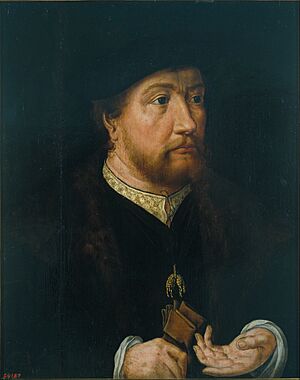
In 1526, John Frederick of Saxony sent William some of Luther's writings. After this, William slowly started to bring the new teachings to his county. He made rules about church practices. William was a calm but determined person. He became convinced that the new faith was true.
In 1530, William attended the Diet of Augsburg. There, Protestant princes presented their beliefs. When William returned, he formally introduced the Augsburg Confession in Dillenburg. He ended celibacy (priests not marrying) and the Catholic mass. William moved carefully. He had to consider the Emperor and his brother. He also had to deal with the local church leaders.
William brought in new ministers who supported the Reformation. He got help from Saxony, especially from Philipp Melanchthon. Melanchthon helped bring Erasmus Sarcerius to the county. Sarcerius helped complete the Reformation and improved the school system. He became a rector, court preacher, and spiritual inspector. He reorganized the church system on a Protestant basis.
In 1543, Melanchthon visited Siegen. Archbishop Herman V of Cologne also sought William's advice. The archbishop tried to bring the Reformation to Cologne but failed.
In 1548, William had to let Sarcerius go. The Augsburg Interim was a new imperial rule. It said that Catholic teachings should be followed until a big church meeting. William had to introduce this rule in his county. Many churches were left without pastors. But since the Catholic Church couldn't fill all the spots, many Protestant clergy returned. This changed again after the Peace of Passau in 1552. The Peace of Augsburg in 1555 gave Protestant German states freedom of religion. It also allowed rulers to choose the religion for their subjects.
The Katzenelnbogen Inheritance Dispute
A huge challenge for William was the long argument over the rich County of Katzenelnbogen. This fight with the Landgraviate of Hesse lasted for many years. It cost William's county a lot of money. He spent a lot on legal cases and on making Dillenburg Castle a strong fortress. The County of Katzenelnbogen was very wealthy. It had many Rhine tolls (fees for using roads or rivers).

After William's father died in 1516, William and his brother Henry continued the legal case. Henry's high position and close relationship with Emperor Charles V helped the Nassaus. Their opponent was Landgrave Philip I of Hesse. Philip had control of the disputed land.
In 1523, a court decision in Tübingen favored William. It gave him almost the entire inheritance. But Philip of Hesse ignored the Emperor's orders. The Emperor was far away in Spain.
The political and religious problems of the time, like wars with France and the Turks, kept the Emperor busy. This made him less interested in the Nassau case. When Henry died in 1538, William became more openly Protestant.
During the dispute, there were often plans for armed attacks on Dillenburg Castle. William feared Philip would attack him. He asked his brother for money for defense. William made Dillenburg Castle very strong. He built new bastions (fortified parts) and added cannons.
Construction of the "High Wall" began around 1525. It was a huge structure, 300 meters long and 20 meters high. William wrote that he was "compelled to a construction and fortification in a high degree." Philip saw William as his biggest enemy. He called William a "papist servant" who wanted to take his land.
The long court case was very expensive. William needed money for weapons and soldiers. His brother Henry promised help. From 1539, an artillery master, Johann Opferkampf, oversaw the cannons and even cast new ones. A cistern (water tank) was built in 1547 for a siege.
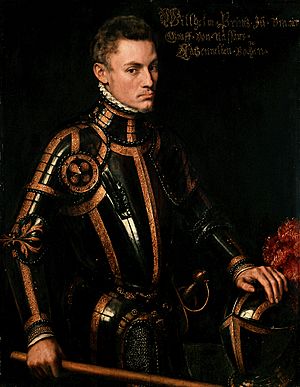
In 1551, Dillenburg received threats of a new invasion. William wrote to his son, Prince William of Orange, that Hesse could reach Dillenburg in one day. Soldiers were brought in from the Netherlands. The city church was also made part of the castle's defenses. The city walls were strengthened.
William was good at mediating, but he struggled to get his own rights. Philip of Hesse often broke his promises. In 1552, William even gave Philip safe passage through Nassau, despite their past. Philip offered much in return but did not keep his word. Dillenburg Castle's strong defenses prevented any Hessian attack.
Finally, an agreement was reached in Frankfurt on 30 June 1557. Hesse paid Nassau 600,000 guilders. Hesse also gave Nassau parts of the County of Diez and other districts. The castle, city, and district of Herborn became fully part of Nassau. Nassau was allowed to use the title "Count of Katzenelnbogen" and its coat of arms. This agreement was signed by Philip of Hesse, William, and William's eldest son, Prince William of Orange.
The final agreement was signed in March 1558. The transferred districts were given to Nassau in April. This ended a dispute that had lasted over 50 years and cost a lot of money. William's territory became much larger and more unified.
The Counts of Nassau fought not just for inheritance. They also fought for the rights of smaller states against powerful princes. This struggle helped the Holy Roman Empire stay together. The Counts of Nassau became leaders in this fight.
To support his claims, William's advisor, Wilhelm Knüttel, wrote a book about the Nassau family history. This book helped show their right to resist.
Later Years and Legacy
The end of the Katzenelnbogen dispute improved relations between Hesse and Nassau. However, Nassau was left with a lot of debt. Despite earning 50,000 guilders a year, the county owed over 500,000 guilders. The payments from Hesse helped, but they weren't enough to solve all the financial problems.
Even with the debts, William continued to host grand celebrations. A famous triple wedding took place on 6 June 1559 in Dillenburg. His son John married Elisabeth of Leuchtenberg. His daughters Anne and Elisabeth also got married. The castle had been beautifully renovated for these events.
William died in Dillenburg on 6 October 1559, two years after the peace agreement. In his will, he asked to be buried in the church in Siegen or Dillenburg. He wanted a simple funeral. He was buried in the choir of the Dillenburg parish church. This is now the Fürstengruft in the Evangelische Stadtkirche.
William was succeeded by his sons John, Louis, Adolf, and Henry. They divided the county in 1560. John managed the county for his younger brothers. In 1561, they also inherited the County of Nassau-Beilstein.
Why William Had Nicknames
The Elder
In William's time, rulers were not usually numbered like kings. When a father and son had the same name, they were called "the Elder" and "the Younger." So, William I was called Wilhelm der Ältere (the Elder). His son, William the Silent, was later known as "the Younger."
The Rich
It's not fully clear why William was called "the Rich." Some historians think it was because he had many children. However, he only had one daughter when he was first called "the Rich" during the German Peasants' War (1524–1525).
Another idea is that people called him "the Rich" after he gained the Katzenelnbogen inheritance. With a good income and ownership of many iron smelters and lands, his subjects would have seen him as very wealthy.
Marriages and Children
First Marriage
William married Countess Walburga of Egmont on 29 May 1506. She was born around 1489 and died on 7 March 1529.
William and Walburga had two daughters:
- Elisabeth (born October 1515 in Siegen – died January 1523).
- Magdalene (born 6 October 1522 in Siegen – died 18 August 1567). She married Count Herman of Neuenahr and Moers in 1538.
Second Marriage
William married Countess Juliane of Stolberg-Wernigerode on 20 September 1531 in Siegen. She was born on 15 February 1506 and died on 18 June 1580 in Dillenburg. Juliane had been married before to Count Philip II of Hanau-Münzenberg.
William and Juliane had many children:
- Prince William I the Silent of Orange (born 24 April 1533 in Dillenburg – murdered 10 July 1584 in Delft). He became Prince of Orange in 1544. He married four times:
- Anna van Egmont in 1551.
- Duchess Anne of Saxony in 1561 (marriage ended in 1571).
- Duchess Charlotte de Bourbon-Montpensier in 1575.
- Countess Louise de Coligny in 1583.
- Hermanna (born 9 August 1534 – died young).
- Count John VI the Elder (born 22 November 1536 in Dillenburg – died 8 October 1606 in Dillenburg). He became count after his father in 1559. He married three times:
- Elisabeth of Leuchtenberg in 1559.
- Countess palatine Kunigonda Jacoba in 1580.
- Countess Johannette of Sayn-Wittgenstein in 1586.
- Count Louis (born 10 January 1538 in Dillenburg – died 14 April 1574). He also became count in 1559. He died in the Battle of Mookerheyde.
- Mary (born 18 March 1539 in Dillenburg – died 18/28 May 1599). She married Count Willem IV van den Bergh.
- Count Adolf (born 11 July 1540 in Siegen – died 23 May 1568). He became count in 1559. He died in the Battle of Heiligerlee.
- Anne (born 21 September 1541 in Dillenburg – died 12 February 1616 in Weilburg). She married Count Albert of Nassau-Weilburg in 1559.
- Elisabeth (born 25 September 1542 in Dillenburg – died 18 November 1603). She married Count Konrad of Solms-Braunfels in 1559.
- Catherine (born 29 December 1543 in Dillenburg – died 25 December 1624). She married Count Günther XLI 'Bellicosus' of Schwarzburg-Arnstadt in 1560.
- Juliane (born 10 August 1546 in Dillenburg – died 31 August 1588). She married Count Albert VII of Schwarzburg-Rudolstadt in 1575.
- Magdalene (born 15 December 1547 in Dillenburg – died 16 May 1633 in Öhringen). She married Count Wolfgang of Hohenlohe-Weikersheim in 1567.
- Count Henry (born 15 October 1550 in Dillenburg – died 14 April 1574). He became count in 1559. He was killed in the Battle of Mookerheyde.
Illegitimate Child
William had one son outside of marriage:
- Gottfried von Nassau (died in Kirberg on Good Friday 1582). He was Lord of Löhnberg and Camberg. He married three times:
- Anna von Wied.
- Irmgard Schlaun in 1557.
- Ursula von Bergen genannt Kessel around 1577.
Founder of the Dutch Royal Family
William is considered the ancestor of the Dutch royal house. His eldest son, William the Silent, led to later Dutch leaders like Maurice and William III. His second son, John, led to other Dutch leaders like William IV and King William I of the Netherlands.


